G.Skill Phoenix Blade (480GB) PCIe SSD Review
by Kristian Vättö on December 12, 2014 9:02 AM ESTRandom Read/Write Speed
The four corners of SSD performance are as follows: random read, random write, sequential read and sequential write speed. Random accesses are generally small in size, while sequential accesses tend to be larger and thus we have the four Iometer tests we use in all of our reviews.
Our first test writes 4KB in a completely random pattern over an 8GB space of the drive to simulate the sort of random access that you'd see on an OS drive (even this is more stressful than a normal desktop user would see). We perform three concurrent IOs and run the test for 3 minutes. The results reported are in average MB/s over the entire time.
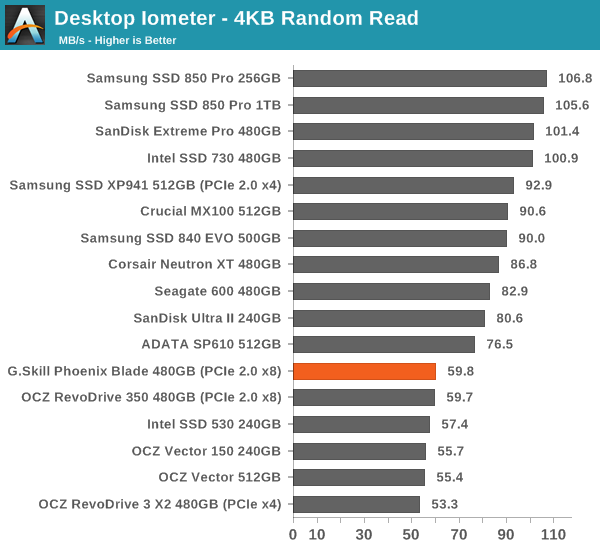
Random read speed is typical SandForce, which makes sense because the performance doesn't scale across multiple controllers at such low queue depths (QD=3 in this case).
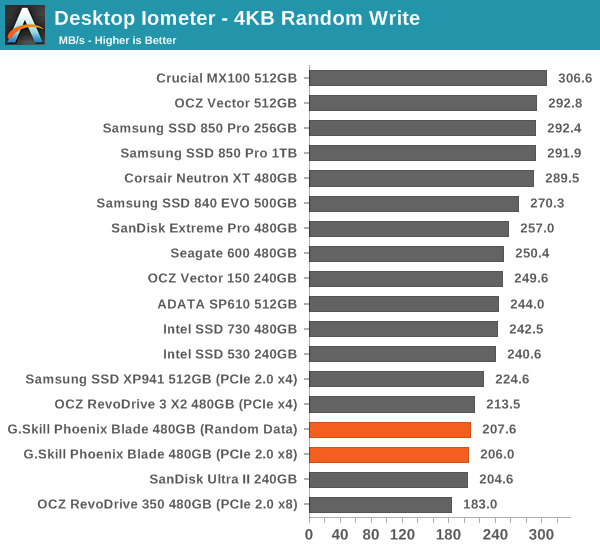
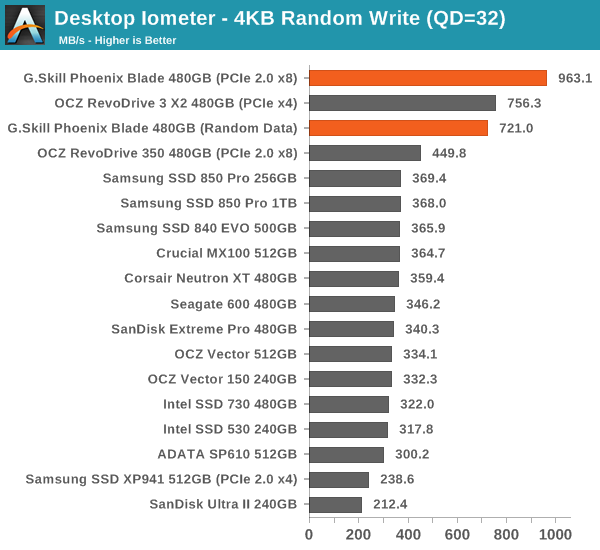
The same goes for random write performance at queue depth of 3, which isn't very high but is normal for SandForce based drives. However, the Phoenix Blade scales brilliantly with the queue depth and is considerably faster than the XP941 or RevoDrive 350.
Sequential Read/Write Speed
To measure sequential performance we run a 1 minute long 128KB sequential test over the entire span of the drive at a queue depth of 1. The results reported are in average MB/s over the entire test length.

Sequential performance is also excellent, although the XP941 enjoys a slight advantage in sequential read performance. Overall the Phoenix Blade seems to be well optimized for parallelism -- much better than the RevoDrive 350 -- as it's able to provide substantially higher performance than SATA drives.
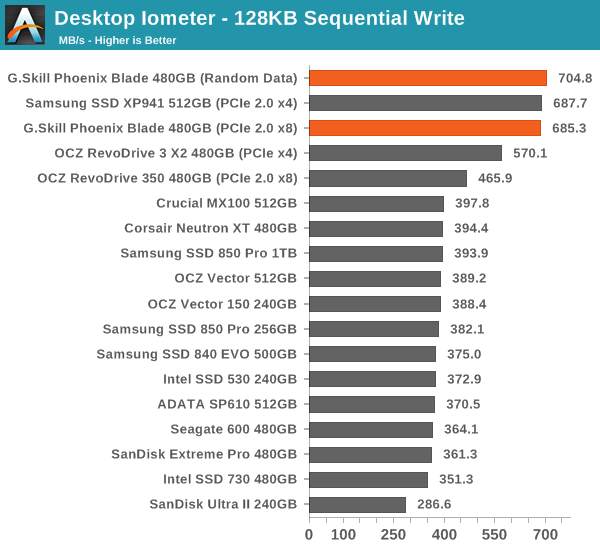
AS-SSD Incompressible Sequential Read/Write Performance
The AS-SSD sequential benchmark uses incompressible data for all of its transfers. The result is a pretty big reduction in sequential write speed on SandForce based controllers, but most other controllers are unaffected.
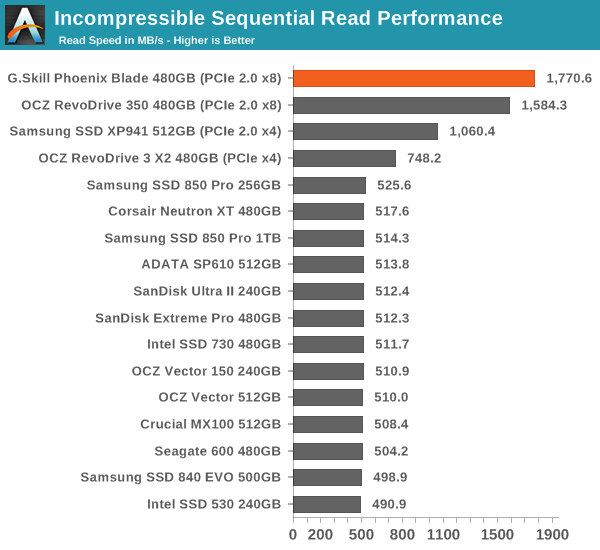
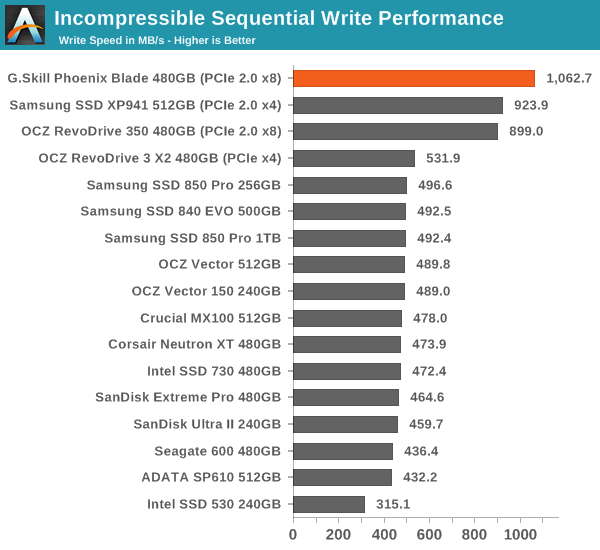










62 Comments
View All Comments
otherwise - Monday, December 15, 2014 - link
For those interested, here is the P3xxx series page at intel, which used to contain all three models, but now just the P3600 and P3700: http://www.intel.com/content/www/us/en/solid-state...otherwise - Monday, December 15, 2014 - link
Fixed link: http://www.intel.com/content/www/us/en/solid-state...r3loaded - Friday, December 12, 2014 - link
Is anyone ever going to get around to producing a native PCIe drive that's actually available at retail for enthusiasts to buy for their systems? Bonus points if it supports NVMe. The SSD in my MacBook Pro is faster than the one in my desktop PC and that just doesn't sit right with me.biostud - Friday, December 12, 2014 - link
Can't it boot from a X99 setup?FunBunny2 - Friday, December 12, 2014 - link
The text says 2281, but the table 2282?? Typo? Matter much?Antronman - Friday, December 12, 2014 - link
For just $300 more, I'll take an iO-FX any day over this PCIe SSD.Poik - Friday, December 12, 2014 - link
Only price I see for an iO-FX is $1380 from Amazon. That's pretty much $700 more or double the price. Even so for an extra $300 I'd rather have 2 XP941's.Antronman - Friday, December 12, 2014 - link
I was comparing Amazon costs, as I found the Phoenix Blade 480GB for $1000 on Amazon. But after checking Newegg, it is only $680 on Newegg. Oh well. The iO-FX is still worth it. The speed and reliability is simply second to none. While it might be a little bit overkill for the average consumer, I don't believe PCIe SSDs (especially ones this expensive) are for the average consumer. If you're buying a single storage drive that costs $680, you can buy a storage drive that costs $1400.bill.rookard - Friday, December 12, 2014 - link
Interesting piece of hardware, but I'm interested in it more for my used servers. I have several running and something with that kind of durability rating and the all important backwards compatibility and form factor would allow me to have all kinds of fun with that on my Xeon box.Of course, two of them would set me back $1500.00 - details, details.
Supercell99 - Saturday, December 13, 2014 - link
My guess is for a server environment, something that has to be 24/7, a product this new should be tested for a while before I would put it into a production machine, just to see what happens :)